Putah Creek, a remarkable tailwater fishery flowing from Lake Berryessa in California, is renowned among anglers for its challenging yet rewarding fly fishing experience. Emerging from springs high on Cobb Mountain and meandering downstream, this 4.5-mile stretch below Monticello Dam offers a unique habitat, rich in nutrients from Lake Berryessa, famously dubbed the “Green River.” For those wondering, Is Putah Creek Fly Fishing Only? The answer is yes, and this designation is key to maintaining its exceptional wild trout population.
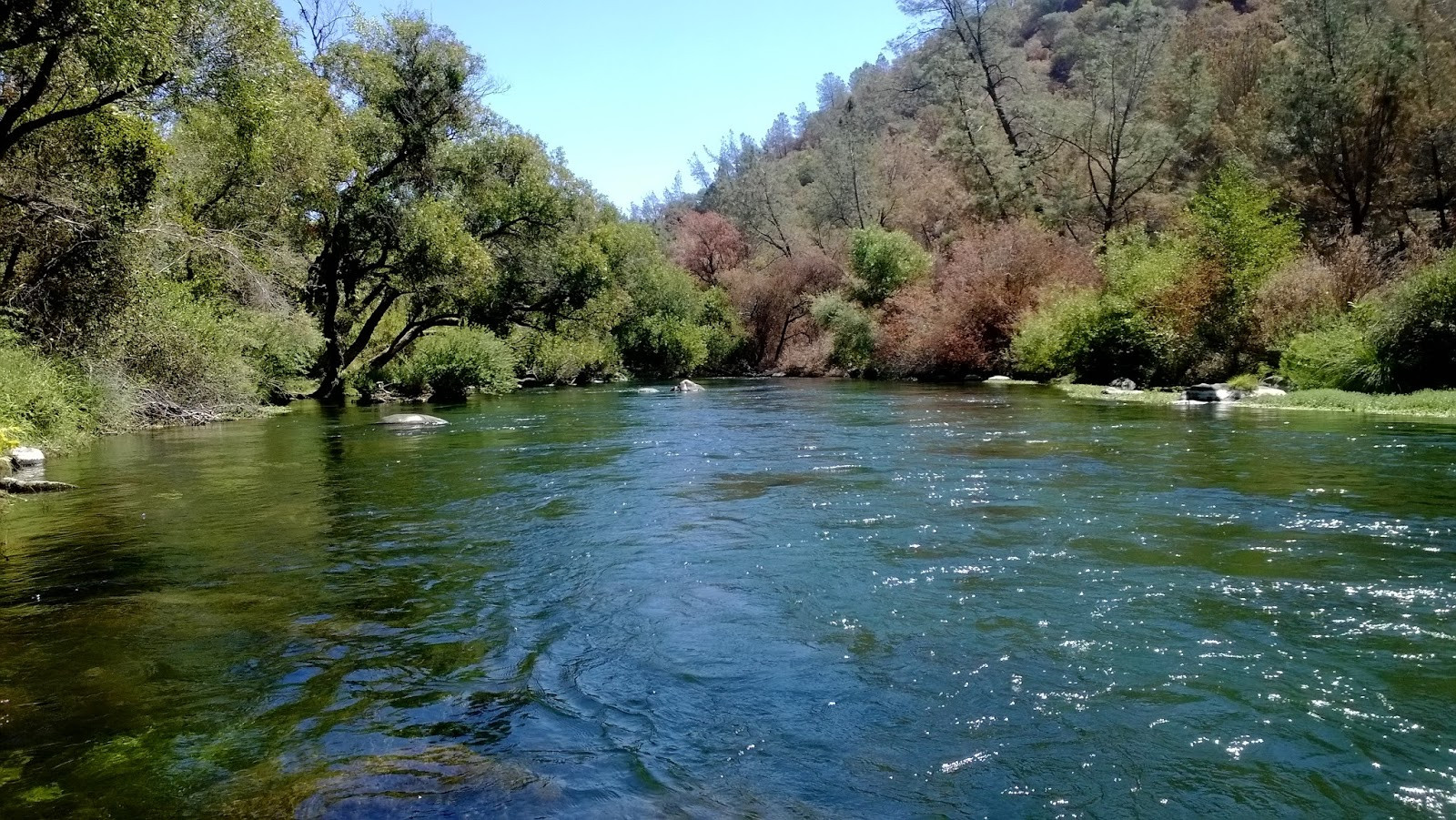
Angler casting a fly rod in the clear waters of Putah Creek, California, surrounded by lush greenery, embodying the essence of fly fishing in a natural setting.
Prior to 2010, Putah Creek operated as a put-and-take fishery. While tales and images of large brown trout from that era still circulate online, the creek has undergone a significant transformation since becoming a designated wild trout fishery in 2014. Brown trout are no longer present; instead, a thriving, self-sustaining population of wild rainbow trout now dominates the Putah Creek ecosystem. This shift underscores the importance of the fly fishing only and catch-and-release regulations in preserving this delicate environment.
Putah Creek has earned a reputation as a technical fishery, challenging even seasoned anglers. Its fluctuating flows, submerged trees, weedy bottoms, overhanging branches, tight casting spaces, deep runs, and dense blackberry bushes all contribute to its notorious difficulty. While these elements create an ideal habitat for large trout to flourish, they can present considerable obstacles for anglers unfamiliar with the creek’s nuances. Understanding the fly fishing only rules is just the first step; mastering the creek requires adapting to its complex nature.

Close-up shot of a barbless hook and artificial lure, highlighting the specific tackle requirements for fly fishing in Putah Creek’s designated area.
Putah Creek Fly Fishing Regulations and Access
Open Season: From Lake Solano to Monticello Dam, Putah Creek is open for fishing year-round.
Regulations:
- Fly Fishing Only: The most critical regulation is that Putah Creek is fly fishing only. This means only artificial lures and flies are permitted.
- Barbless Hooks: Barbless hooks are mandatory to minimize harm to the wild trout population, emphasizing the catch-and-release nature of the fishery.
- Zero Limit: There is a zero limit on trout.
- Catch-and-Release Only: Catch-and-release is strictly enforced. All fish caught must be immediately and safely returned to the water.
Important Unwritten Rule: It is considered best practice and highly recommended to avoid fishing Putah Creek from November/December through February. This period is crucial for winter spawning, and the limited spawning habitat makes the fish particularly vulnerable. Respecting this voluntary closure is essential for the long-term health of this exceptional fishery.
Access Points: Several fishing access points with parking are available along Highway 128, along with designated turn-offs. Parking is free at most locations, with the exception of Lake Solano. A $10 parking fee was implemented at all fishing access spots on July 1st, 2019.
Detailed Access Point Descriptions:
- Putah Creek Wildlife Area: The first access point downstream from Monticello Dam features two undeveloped parking lots. This section offers diverse water types, including riffles, runs, and pools of varying depths.
- Canyon Creek Resort: While the Canyon Creek Resort area is private, anglers can fish the opposite bank if they can cross the creek.
- “Deer Sign” Access: Downstream from Canyon Creek Resort, look for a deer crossing sign along Highway 128. A small turnout marks the “Deer Sign” access. This section begins with a long, deep run. Crossing the creek (at flows below 200 CFS) improves access to riffles, runs, and pools further downstream. The deep run can also be reached by hiking downstream from the Putah Creek Wildlife Area.
- Fishing Access #1 & #2: This is the first designated parking lot access downstream. It features deep runs and pools, along with some shallower riffles and runs. Access #2 is reached by hiking downstream from the parking lot at Access #1.
- Fishing Access #3: The second parking lot access downstream (Access #3) offers some of the deepest runs in Putah Creek. A small riffle marks the end of this section before the water transitions into a glassy, spring-creek-like environment.
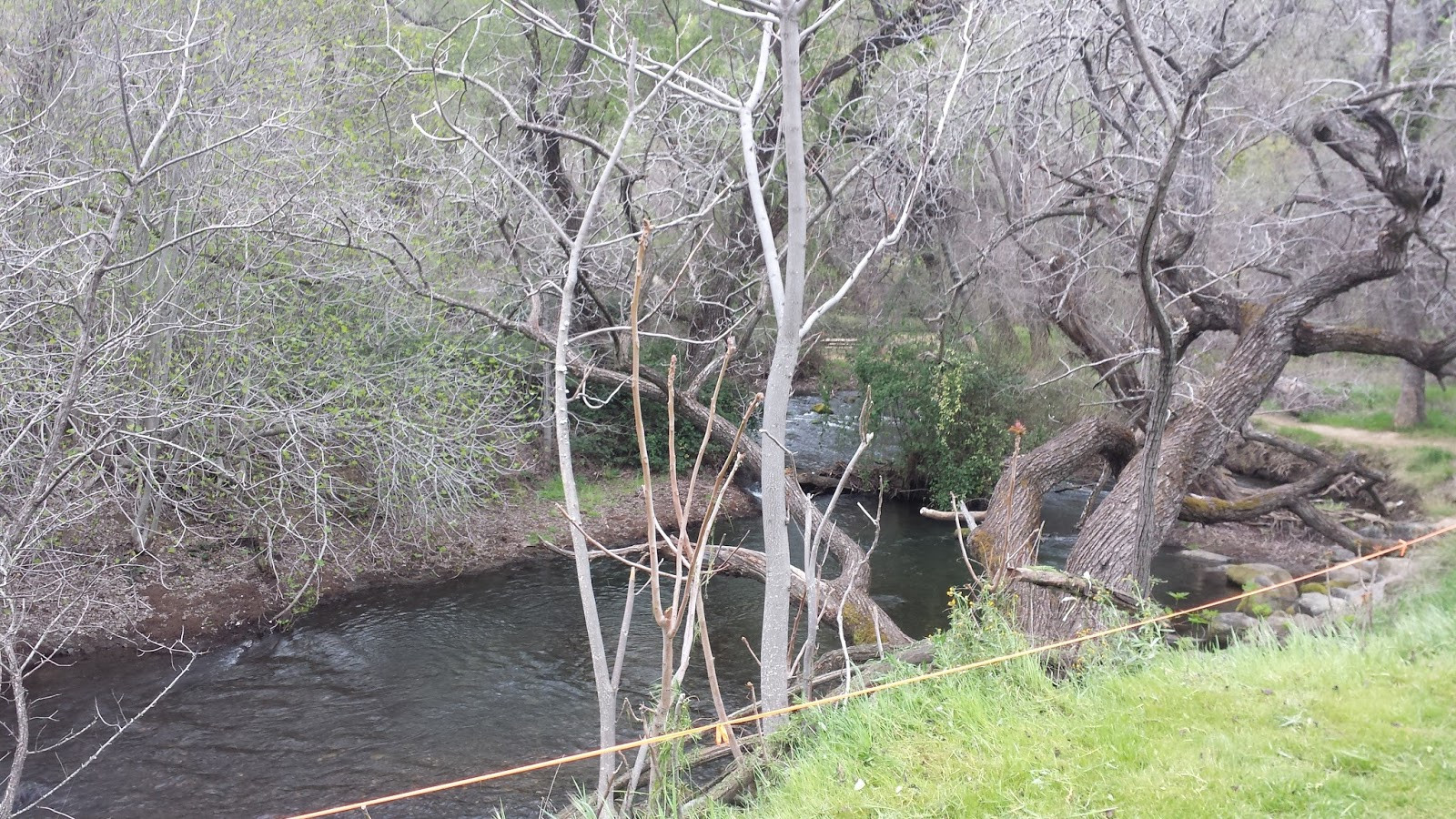
Image displaying the “Access 3 Spawning Riffle” area of Putah Creek, showcasing the natural spawning habitat and riffle structure relevant to the fly fishing environment.
- Fishing Access #4: The third parking lot access downstream (Access #4) is characterized by a long run with a tailout, pool, and run. The run gradually shallows and connects to Access #5. This shallower section is crossable at flows below 450 CFS.
Visual representation of “Access 4 Run” in Putah Creek, emphasizing the run’s characteristics and water flow, typical for fly fishing in this location.
- Fishing Access #5: The final parking lot access downstream (Access #5) is where the creek flows around an island, creating attractive riffles and pools. Access #5 is relatively shallow, easily wadeable, and crossable at flows below 500 CFS. Below Access #5, Putah Creek flows into Lake Solano.
Photo depicting “Access 5 Riffles” at Putah Creek, illustrating the riffle habitat favored by trout and commonly targeted by fly fishermen.
Fly Fishing Seasons on Putah Creek
Understanding the seasonal changes on Putah Creek is crucial for successful fly fishing.
Spring (March – May):
Spring marks the official opening of the fishing season on Putah Creek on March 1st. By this time, most trout have concluded spawning, and flows typically increase from a low of 100 CFS to around 200 CFS, gradually rising throughout the season. Anglers should exercise caution and avoid wading excessively, as unhatched eggs may still be present in the creek bed. Midges and BWOs (Blue-Winged Olives) are staple fly patterns for Putah Creek year-round, and spring is no exception. Spring often draws crowds to Putah Creek due to its wadeable flows. To find success in fished-over waters, consider unconventional spots and techniques.
Summer (June – August):
Summer flows on Putah Creek begin at 400 CFS and can peak at 600 CFS. Fishing is often most productive in the mornings and evenings as water temperatures rise. Caddis become more active in the warmer months. Patterns imitating emerging caddis pupae, such as Prince Nymphs or Fox’s Poopah, are effective choices. Streamer fishing with patterns like the Hero Sculpin can also be productive in the summer, especially for targeting larger trout. Covering a lot of water is key when streamer fishing during higher flows. While summer fishing can be challenging due to high flows, remember that trout still need to feed.
A scenic view of Putah Creek in the summer, showcasing the higher water levels and lush bank vegetation typical of the season, relevant for summer fly fishing considerations.
Fall (September – November):
Similar to spring, fall sees an increase in angler activity on Putah Creek as flows gradually decrease, opening up areas that were inaccessible during the summer. Streamers and nymphs remain effective as trout feed actively to prepare for the upcoming spawn. By November, most anglers cease fishing Putah Creek to protect spawning fish. Some anglers and guides may even stop fishing earlier in the fall to further minimize disturbance and support the fishery’s health. This voluntary cessation marks the end of the fishing season until March.
Winter (December – February):
Winter is the spawning period for trout in Putah Creek. With minimal flows, it is crucial to refrain from fishing to avoid disrupting spawning activity. Instead, explore other excellent winter fisheries nearby, such as the Lower American, Lower Yuba, Feather, and Sacramento Rivers. Respecting the fly fishing only, catch-and-release regulations and the unwritten rule of avoiding fishing during spawning season are paramount to the continued health of Putah Creek.
Fish Species, Gear, and Fly Patterns for Putah Creek Fly Fishing
Fish Species: Putah Creek is primarily a rainbow trout fishery.
Recommended Gear for Putah Creek Fly Fishing:
- Rod Weight: 5WT or 6WT fly rod
- Line: Floating fly line
- Leaders: Rio Versileaders, 9′ – 12′ tapered leaders in 4x or 5x
- Net: A decent sized landing net is recommended, especially for the larger trout Putah Creek is known for.
Effective Fly Patterns for Putah Creek:
Nymphs:
- Pheasant Tail (#16 – 18)
- S&M Nymph (#16 – 18)
- Copper John (#16 – 18)
- Prince Nymph (#14 – 18)
- Zebra Midge (#18 – 20)
- Juju Baetis (#18)
- Juju Midge (#18)
- Micro May (#18)
- Putah Riffle Special (#18)
- WD-40 (#16 – 20)
Wet Flies:
- Soft Hackle (#14 – 18)
- Bird’s Nest (#14 – 18)
- San Juan Worm (#6 – 8)
Dry Flies:
- Adams (#18)
- EH Caddis (#18)
Streamers:
- Woolly Bugger (#4 – 6)
- Sculpinzilla (#4)
- Zonker (#4)
- Hero Sculpin (#4 – 6)
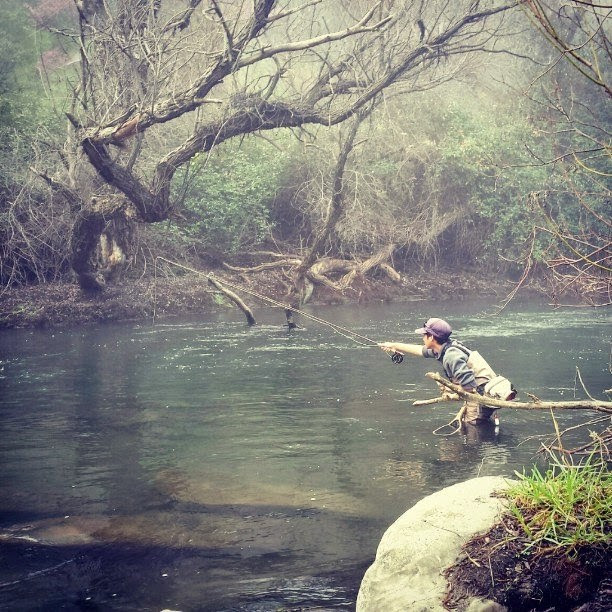
Image showcasing a selection of fly fishing nymphs, including pheasant tail and zebra midge patterns, essential for imitating subsurface trout food sources in Putah Creek.
Fly Fishing Techniques for Putah Creek
Nymphing: Nymphing is the most prevalent and effective fly fishing technique on Putah Creek. While smaller trout may occasionally rise to dry flies on warm evenings, Putah Creek trout primarily feed subsurface approximately 95% of the time. Surprisingly, even the largest trout in Putah Creek often prefer tiny flies. A common nymphing rig consists of an indicator, split shot, and a size 16 nymph, often with a size 18 dropper. Larger fish exceeding 20 inches frequently take the smaller size 18 dropper. Go-to colors for nymphs on Putah Creek are black and olive in darker shades.
When flows are high, utilize a long 10′ or 12′ 5x leader and a heavier split shot to ensure your flies reach the fish holding deeper in the water column. In lower flows, a standard 9′ leader may suffice. Reading the water and adjusting your setup accordingly is crucial for success on Putah Creek. Be prepared to add or remove split shot throughout the day depending on the water type you are fishing. Putah Creek is an excellent place to refine your indicator nymphing skills. Smaller indicators (1/2 inch or less) are favored for a stealthier presentation and to detect subtle strikes. Due to the creek’s deceptive depth, lengthening your leader tippet can help your flies sink faster and reach deeper holding zones. Putah Creek’s abundant weeds necessitate frequent fly checks for debris, as trout are unlikely to take fouled flies.
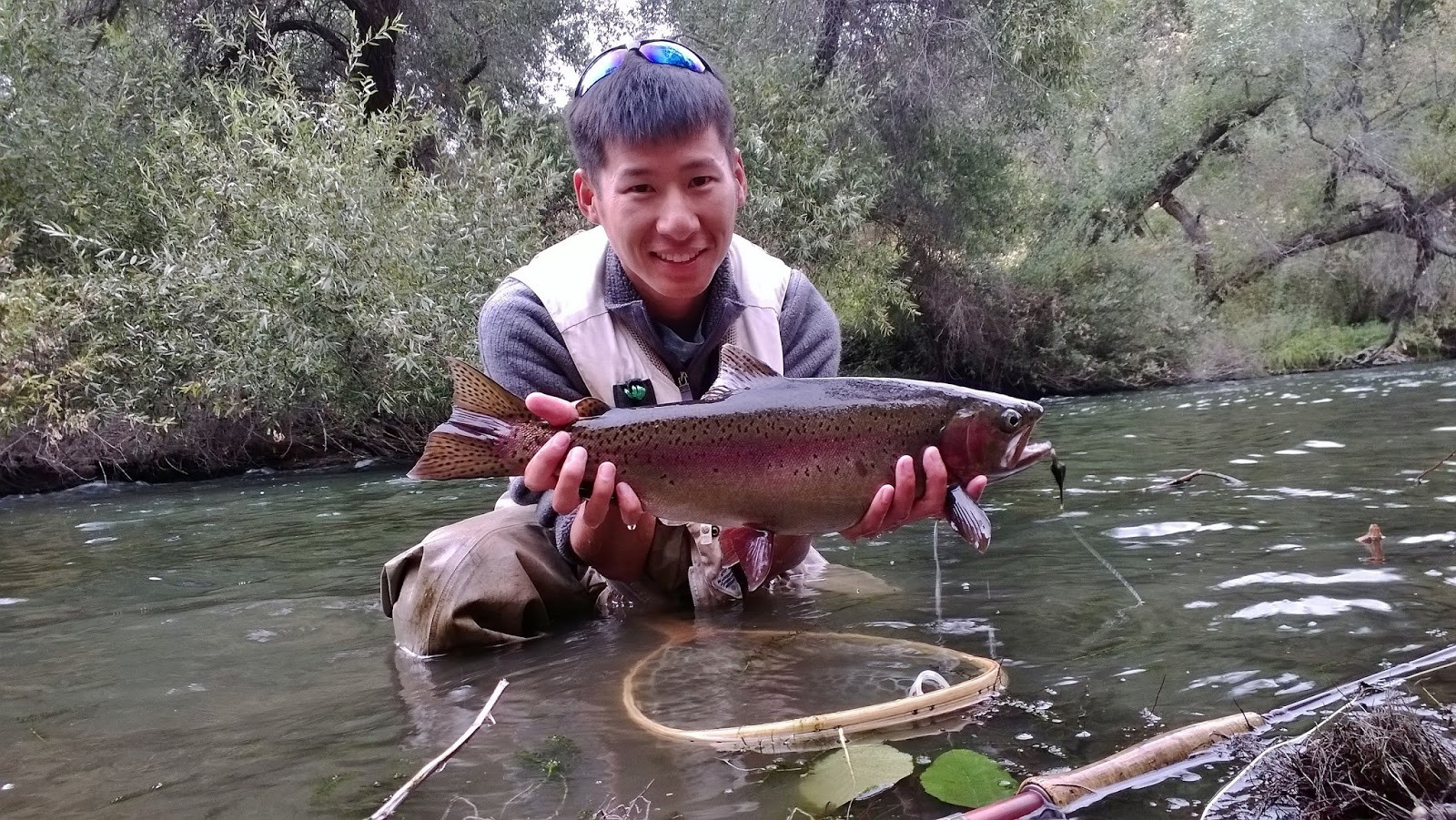
Image of an angler expertly roll casting a fly rod in Putah Creek, demonstrating a key technique for navigating the creek’s vegetation and tight casting spaces.
Streamer Fishing: Streamers can be effective on Putah Creek when flows exceed 200 CFS. A recommended streamer setup includes an extra fast sinking 10′ versileader, a 4′ section of 10# monofilament leader, and a streamer fly tied with a loop knot. Cast streamers upstream, allow them to sink, and retrieve with steady two-inch strips as the streamer swings downstream. Cover as much water as possible when streamer fishing. While streamer fishing may not yield high numbers of fish, the fish caught are often larger specimens. The heavier line class is beneficial for landing larger trout in Putah Creek, offering more forgiveness than lighter tippet like 5x. Developing a proficient roll cast is essential for fly fishing Putah Creek due to dense blackberry bushes and overhanging trees limiting backcasting space.
Fighting Trophy Trout: Be prepared to encounter trophy-sized trout in Putah Creek, as approximately 10% of the trout population reaches trophy dimensions. Landing these fish can be challenging, so ensure you have a suitable net and refined fish-fighting skills. Expect to lose more trophy fish than you land – persistence and composure are key.
Optimal Flows and Crowds on Putah Creek
Optimal fishing flows on Putah Creek are generally between 200 – 350 CFS. Wading can be moderately challenging but safe and manageable at these levels. Most crossing points are accessible within this flow range, opening up approximately 90% of the creek. Flows in the 100-150 CFS range are often considered too low, making fishing and locating fish more difficult. Flows exceeding 450 CFS are considered high and can limit fishable areas, although fishing is still possible with adjustments to technique and approach.
Putah Creek can become crowded on weekends and even weekdays. If fishing during peak times, seek out overlooked water or return to prime spots later in the day. Don’t neglect less obvious areas like nooks, crannies, and slow water – surprisingly large fish can often be found in these overlooked locations.
Protecting Putah Creek: Invasive Species
Putah Creek faces a significant infestation of New Zealand mud snails. To prevent further spread of these invasive snails, thoroughly clean your gear or allow it to dry completely for several days before fishing in other bodies of water. Adhering to the fly fishing only regulations, practicing catch-and-release, respecting spawning season closures, and preventing the spread of invasive species are all crucial steps in preserving the exceptional Putah Creek fishery for future generations.
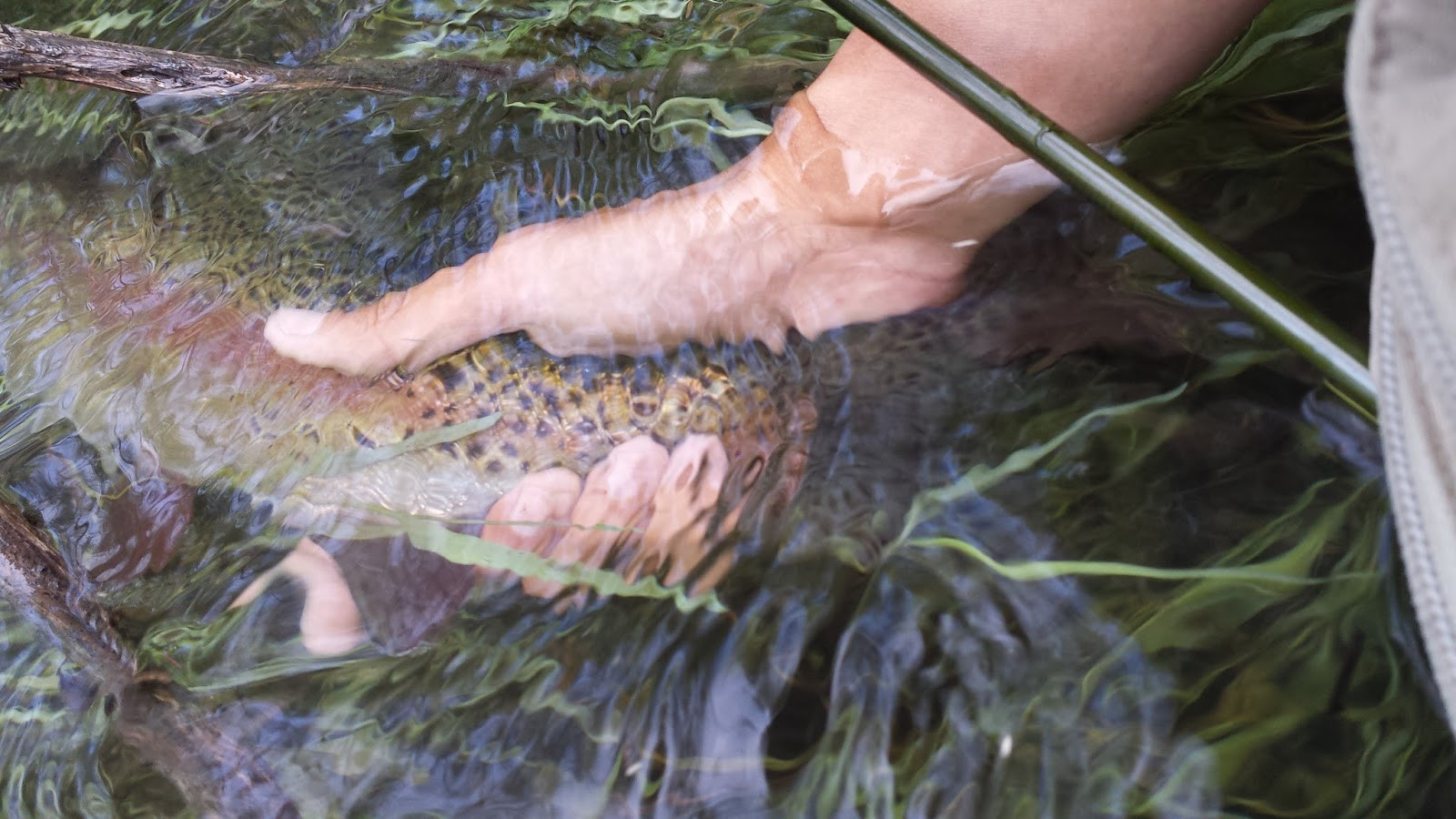
Image of an angler releasing a rainbow trout back into Putah Creek, reinforcing the catch-and-release ethic crucial to the sustainability of this fly fishing only destination.